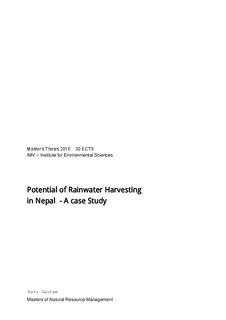| dc.description.abstract | This paper gives an overview of RWHS in urban Kathmandu valley (27°32’13”- 27°49’10” N 85°11’31” & 85°31’38” E). The rainwater collection is during monsoon season (June-August) and some amount of water can be collected by rainwater in dry period to minimize the daily water demand among different households. The main study of research is to analyze and interpret the collected rainwater and household catchment area together to know the capacity of individual household of different land sizes. The research ultimately gives the framework of design storage tank depending on amount of rainfall collected from different roof catchment areas.
The annual rainfall data of Kathmandu valley (2003-2013) is collected from department of hydrology and meteorology. The roof catchment area and land size data of different households in ward-9 were collected from ward office of KMC. The household land sizes and roof catchment area of different land area (2-4,4-6,6-8,8-10,10-12) Anna gives different rainwater harvesting potentially that amount of rainwater can be harvested. This is basis for design of the harvesting system. The capacity of collecting rainwater depends on roof catchment area and there is more collection of rainwater as the catchment roof area increases accordingly with respect to land area. The monthly precipitation of Kathmandu valley is more in June – September with monthly precipitation of 215mm, 375 mm, 315 mm and 244 mm and average area roof surface of 2-4 Anna is 72.66m2 and it increases to 167.38m2 of 10-12 Anna.
The collected data shows that there is high potential of water harvesting and collected water can be useful as a domestic resource. The household member gets benefitted with an additional water source by the use of simple and easily accessed technology. In the same way there is less water supply pressure to the government and authorized institutional bodies, and ultimately beneficial for environmental risk of flooding as well. | nb_NO |

